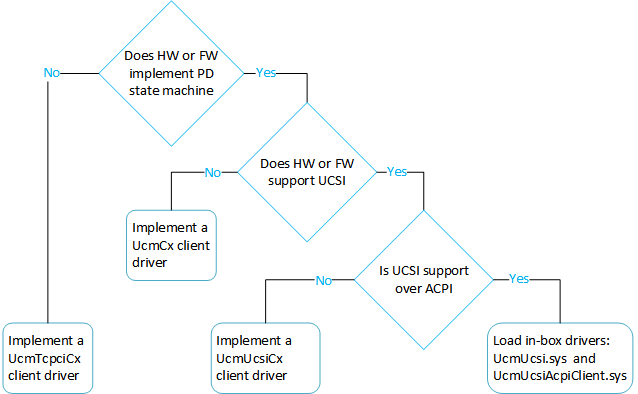Overview of developing Windows drivers for USB Type-C connectors
You need to write a driver for the connector if your USB Type-C system does not implement a PD state machine, or it implements the state machine but does not support UCSI over a non-ACPI transport. If it does, you can load the Microsoft-provided UCSI driver.

Proposed solutions
The following table recommends solutions based on hardware or firmware capabilities:
| Hardware/Firmware capabilities | Non-detachable | Add-on card |
|---|---|---|
| USB Type-C connector does not have a PD state machine. | Write a client driver to UcmTcpciCx. Start with UcmTcpciCx Port Controller Client Driver |
Write a client driver to UcmCx. Start with the UcmCx sample. |
| Connector is UCSI-compliant with ACPI. | Load the in-box driver, UcmUcsiCx.sys and UcmUcsiAcpiClient. See USB Type-C Connector System Software Interface (UCSI) driver. | N/A |
| Connector is UCSI-compliant without ACPI. | Write a client driver to UcmUcsiCx. For more information, see Write a UCSI client driver. Start with the UcmCx sample and replace the ACPI portions with your implementation for the required bus. |
Write a client driver to UcmCx. |
| Has PD state machine but is not UCSI-compliant. | Write a client driver to UcmCx. Start with the UcmCx sample. |
Write a client driver to UcmCx Start with the UcmCx sample. |
In this section
To implement the solutions proposed in the preceding table, read these topics:
| Topic | Description |
|---|---|
| Architecture: USB Type-C design for a Windows system | Describes a typical hardware design of a USB Type-C system and the Microsoft-provided drivers that support the hardware components. |
| Bring up the function controller on a USB Type-C Windows system | The driver for the function controller informs the operating system about the charging levels that its USB Type-C connector supports and notifies the battery subsystem when it can begin charging and the maximum amount of current the device can draw. |
| Bring up the dual-role controller for a USB Type-C Windows system | The USB role-switch drivers (URS) are a set of WDF class extension and its client driver that handles the role-switching capability of a dual-role controller. If your system has a dual role controller, you can switch the role of the system depending on the device that is attached to the partner port of the USB Type-C connector of the system. This allows interesting scenarios such as wired docking. |
| Write a USB Type-C connector driver | Describes the USB connector manager (UCM) that manages a USB Type-C connector and the expected behavior of a connector driver. |
| Write a USB Type-C port controller driver | Describes how to write a the USB Type-C port controller driver that communicates with a USB Type-C connector without PD state machine. |
| Write a UCSI client driver | Describes how to write a driver for a UCSI-compliant controller that uses non-ACPI transport. |
| Write a USB Type-C Policy Manager client driver | The Microsoft-provided USB Type-C Policy Manager monitors the activities of USB Type-C connectors. Windows, version 1809, introduces a set of programming interfaces that you can use to write a client driver to Policy Manager. The client driver can participate in the policy decisions for USB Type-C connectors. With this set, you can choose to write a kernel-mode export driver or a user-mode driver. |
Related sections
- Write a USB role-switch (URS) client driver
- USB dual-role controller driver programming reference
- Write a USB function client driver
- USB function controller programming reference